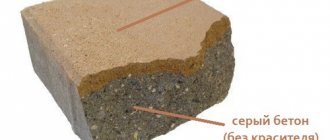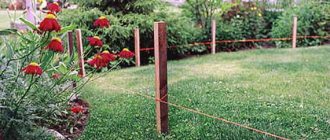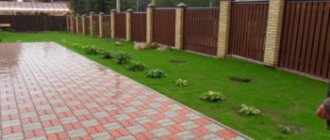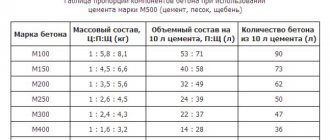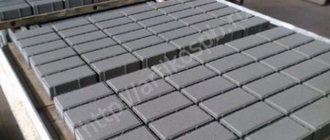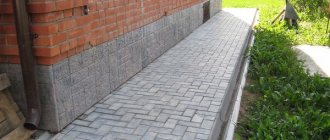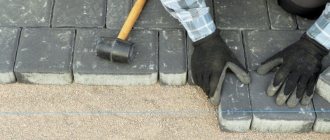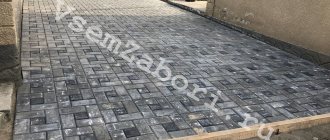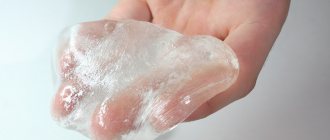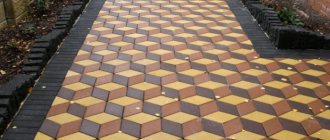Paving slab production technology
There is only one method for producing such a road surface.
Vibrocompression method
Tiles made in this way are characterized by increased wear resistance and durability. Its thickness is at least 35 mm. You can see it on the streets in city parks or squares. It is impossible to make such products yourself without special vibrating cassette molds that compress the concrete mixture.
Vibratory casting method
In this way, elegant products with a beautiful pattern and a small thickness of 10 - 35 mm are obtained. This is exactly what is suitable for self-production of concrete tiles. What equipment you need to have: a regular gravity-type concrete mixer and a small vibrating table. If you want, you can conjure and make it yourself.
It is not recommended to make the mixture for paving slabs too plastic so that they can be laid without preliminary vibration, since such concrete has a low strength, wear resistance and frost resistance. Products obtained in this way are not worth the effort, time and money spent on their production.
Features of home tile making
Since anyone can make a solution for paving slabs with their own hands, we should highlight some features of home production. First of all, during manufacturing it is important to maintain cleanliness and maintain optimal humidity and temperature.
If the technology is followed, it is possible to achieve the production of products with a quality no worse than production variations.
Preparing the mixture yourself allows you to experiment with colors and shapes of the tiles. You can also make your own molds for filling. This requires a polyurethane mixture and a template, such as a store-bought tile or plaster template. In total, 7-12 forms will be enough for work.
The high quality of paving slabs is ensured by compliance with technology.
Workplace
The working area must be clean, humidity and air temperature must be maintained at an optimal level, otherwise the solution can be spoiled and it will lose a significant part of its properties.
The drying process should be carried out on a special vibrating table for working with cement. A vibrating table is a specialized device with a working surface mounted on springs, due to which the surface can perform oscillatory movements.
In addition, you will need tile molds. It is better to use polyurethane molds, as it is easy to remove the frozen solution from them.
Tools and materials
Before you start work, you need to find a vibrating table and prepare the oil substance. The oily substance is necessary to lubricate the molds. A suitable material for a vibrating table is wood or silicone. The main condition for a vibrating table is a perfectly clean and smooth surface. Suitable oil substances include: palm, sunflower or motor oil.
The solution is prepared from the following components:
- 23% M500 cement (it is better to choose a white shade);
- 20% river sand (take fine sifted sand);
- 57% granite crushed stone (particle sizes 3-5 mm);
- Distilled water (water quality is of great importance for mixing concrete);
- Liquid pigment (for coloring tiles);
- Plasticizer (for concrete mobility);
- Dispersant (gives frost resistance to the product).
Ingredient ratio
It is not easy to independently calculate the ratio of components that make up a well-mixed concrete mixture. To do this, you need to go through systematic attempts and offensive mistakes. Therefore, in order to understand what solution is needed, you should talk to a professional. The fact is that even minor errors in calculations can lead to the destruction of previously invested efforts. Mortar for paving slabs loves precise and proven proportions. Deviation from them is highly undesirable. It is better to check the accuracy of the proportions of sand and cement ten times when creating paving slabs, than to later pay for the mistakes made by completely re-laying the surface.
The number of ingredients that need to be put into the mixture, taking into account the need to maintain their certain ratio, depends on:
- quality of purchased building materials;
- operating conditions of the created canvases;
- features of mixing concrete and manufacturing tile elements.
Cement
The main element of any concrete is cement. For the manufacture of paving elements, you should choose medium-aluminate cements with a mineral additive content of no more than 5%, as well as with a strength class of 42.5. The packaging of such a binder indicates the grade CEM I 42.5 N or B. Medium aluminate cements include binders with a C3A content of 5 to 8%. You can find out the aluminate content from the seller by asking for the cement passport.
Fine aggregate
As a fine aggregate, it is best to use washed quarry sand with a particle size modulus of 2 - 2.5.
This material belongs to construction sands of the first class; when used, the concrete composition is characterized by lower consumption of binder and low cost with higher quality indicators.
Coarse aggregate
When using coarse aggregate, it is best to purchase granite crushed stone with a grain size of 3 – 10 mm. Such material will provide increased strength and durability with high mobility of the mixture. But its cost is high, so you can purchase a standard mixture of grains with a diameter of 5 - 20 mm and adjust the recipe, reducing the content of coarse aggregate.
This approach will ensure high mobility and uniformity during the formation of the stone frame in the body of the composite.
What else do you need for self-filling?
In addition to a concrete mixer and a vibrating table, to make paving slabs you will need forms.
Plastic models can be purchased.
Many people make the simplest reusable formwork from wood
Or make unique silicone molds for paving slabs with your own hands.
For plastic and silicone molds, the use of lubricant is optional. If you prepare the solution to the desired hardness, then removing the products should not be difficult.
It is necessary to consider a place for drying concrete samples. If pouring occurs in the summer, then the concrete can reach in natural conditions in no more than a day. If pouring work is carried out in cold weather, it is necessary to ensure constant heating of the improvised dryer to an average of 30 °C.
Independent production
It’s easy to prepare a plasticizer for paving slabs with your own hands, saving money. You just need to follow the step-by-step steps and correctly prepare the plasticizer composition for paving slabs. Be sure to wear gloves when working with solutions.
You can prepare the supplement based on powder, soap or other product:
| The basis | Preparation |
| Lime (protection from mold, temperatures, plasticity, smooth surface) | Suppress the lime, prepare a mixture of sand and cement; add lime; ratio (external work 1:6) |
| Powder | Dilute the powder with water; one bag of cement - a glass of the product |
| Liquid soap | Bucket of dry cement - 2 tbsp. l. soap |
The table shows common options for preparing the additive, as well as how much plasticizer to add to paving slabs. As a plasticizer, try adding washing powder and even chicken protein to the solution. Glass and polyamide fibers are suitable for this purpose. The proportions of plasticizer for paving slabs are different in each case. Any additive should not exceed the norm - 1 kg per cubic meter of concrete.
How to prepare a solution for paving slabs
The composition of the solution includes several components - these are materials for producing concrete and liquid substances. So, the preparation of mortar for tiles occurs by stirring in one container:
- cement (most often experts advise using white material)
- distilled water
- fine river sand (it must be sifted)
- plasticizer, which gives plasticity to the material
- granite crushed stone (fraction should be three to five millimeters)
- liquid pigment
- dispersant, which makes the mixture frost-resistant
The last component (this also applies to pigments) can be added if desired, this is not a prerequisite.
Solution proportions
In order to obtain the ideal composition of the solution for paving slabs, it is important to adhere to the correct ratio of components. The standard mixture for paving slabs includes the following materials:
- cement;
- sand;
- crushed stone;
- plasticizer;
- water.
Dispersant and pigments can be added as desired. Moreover, their presence implies a slight change in the proportions of the mixture. To make paving slabs with your own hands, it is recommended to observe the following proportions of the solution:
- cement – 23%;
- sand – 20%;
- crushed stone – 57%;
- plasticizer – 0.5% of cement;
- water – 40% of dry ingredients;
- dispersant 90 g/m2;
- pigment 700 ml/m2.
Proportional ratio of mortar for paving slabs
The distribution of proportions of dry components is carried out separately. The percentage of water is taken into account from the total mass of dry ingredients. The amount of plasticizer is calculated in relation to the volume of cement used. Dispersant and pigment are added by diluting them in water. To produce 1 m2 of standard colored frost-resistant tiles about 4.5 cm thick, approximately 22 kg of cement, 19 kg of sand, 54 kg of crushed stone, 9 liters of water and 110 g of plasticizer are required.
Initially, you need to thoroughly mix the sand with cement and plasticizer, then crushed stone is added, and at the very end, liquid is added in small portions. The consistency of the solution should be dense enough to stick to the trowel, but not crumble and spread easily when tapped on the mold.
It is best to mix the solution in a concrete mixer; an alternative option is a construction mixer. You can get by with a regular trowel, but it will take more time.
Recipe with plasticizer
The composition of the paving slab solution may consist of the following components:
- white cement;
- river sand of fine structure (pre-sifted);
- crushed stone of granite origin;
- distilled water;
- pigment in liquid form;
- plasticizer (used to make the mixture plastic);
- dispersant (the product will be frost-resistant and homogeneous).
The main thing is to observe the proportions in the solution with plasticizer for paving slabs:
ComponentRatio(%)
| Cement | 23 |
| Sand | 20 |
| Crushed stone | 57 |
| Plasticizer | 0.5 (relative to cement) |
| Water | 40 (to dry ingredients) |
| Dispersant | 90 (g/m2) |
| Dye | 700 (ml/m2) |
Pigment and dispersant may not be introduced. Here everything depends on your desire. When added, they dissolve in an aqueous environment.
For dry components when mixing mortar for paving slabs at home, the calculation is carried out separately from other elements. By looking at the total weight of the dry elements, the water percentage is calculated. See the table for the ratio of cement and sand for paving slabs.
Note:
In order for the composition of paving slabs to be homogeneous, it needs to be mixed for a long time. First, the plasticizer is mixed with cement, then crushed stone is added. Lastly, liquid is gradually added.
The structure of the mixture for paving slabs is quite rich. Before use, check that the mixture does not drip from the working trowel. You can mix the components with a concrete mixer. If you don’t have a special device, you can get by with a trowel. This option will just take longer.
Making mortars for paving slabs: procedure
At the very beginning, it is necessary to mix the sand, cement and plasticizer very well. Then crushed stone is added, and the liquid is added at the very end, and in small doses. If the proportions were observed correctly, the solution will be quite dense and will adhere well to the instrument. It should not spill or crumble. If the composition of the solution for paving slabs was incorrect, or the master violated the technology for its production, the mass may begin to spread. If we get too hard a solution for paving slabs, the proportions were also not met.
The most reliable way is to mix the solution using a concrete mixer. Another method would be to use a construction mixer. These are professional methods, but if there are no such possibilities, you can get by with improvised means, for example, an ordinary trowel will do. It’s just that this method of making solutions for street tiles will require more effort and time.
If you decide that you do not want to prepare the composition for paving slabs yourself, you can turn to professionals.
Facial layer
How to prepare a solution for the outer surface of paving stones? On the outside, the tiles should be beautiful, glossy, and durable. The first layer is made 1.5-2 cm thick. Step-by-step instructions for mixing mortar for the production of paving stones:
- First you need to dilute the dispersant and plasticizer in warm water (temperature 50-60 degrees). The proportions of the solution are as follows: 1 part dispersant: 4 parts water. Shelf life 5 days. When working with these substances, wear gloves and a respirator, protecting exposed skin and mucous membranes;
- A sand-cement mixture is being prepared. To obtain tiles 4.5 cm thick for laying per 1 m2, take 20 kg and 23 kg, respectively;
- for do-it-yourself paving slabs, pour part of the water into a concrete mixer (a total of 18 liters is required), add a dispersant based on the proportion, 1/3 of crushed stone (about 57 kg in total). Mix thoroughly. Pour in the sand-cement mixture and a third of crushed stone, 500 g of fiber, mix the mass, ensuring its homogeneity. Add water and remaining crushed stone. Using such proportions of concrete, the mixture will be plastic, will separate from the walls of the mixer, and will not crumble;
- The molds are lightly greased with oil, laid out on a vibrating table and the first layer of concrete is poured. Turn on the table, vibration helps to get rid of air bubbles, giving strength to the future decorative coating. Vibration is carried out quickly to prevent delamination of the pigment.
Base layer
No more than 20 minutes should pass between pouring the front and base layers. The recipe for concrete for paving slabs for the main layer is as follows: mix crushed stone, concrete, sand, a plasticizer instead of a dispersant, and water. The mixture proportions are standard. Next, pour it into molds.
For gray paving slabs
The proportions of concrete are indicated above for ordinary concrete without dye and luminescent additives. Before making a batch, you need to consider the following nuances:
- region of operation – affects the design frost resistance of figured paving elements;
- soil conditions and climate - with high groundwater level, heavy precipitation and high humidity, the W/C should be reduced and special additives introduced to increase the water resistance of concrete;
- manufacturing technology - when vibro-casting, the surface of the tile is smooth, it is better to use sand with different particle sizes; for a rough surface, vibro-pressed paving stones, coarse sand is more suitable..
Unlike monolithic construction technologies, where an in-depth vibrator can be replaced by manually pouring concrete inside the formwork, making paving elements on your own at home is impossible without a vibrating table, even a homemade one. Vibration solves two problems:
- uniform filling of the polymer mold with a rigid mixture with a low water-cement ratio;
- removing air from concrete to reduce porosity and create a strong, fine-grained structure with low hydrophobicity.
For colored figured paving elements
Paving slabs can be painted in layers or in mass during production. The first method is cheaper, but more difficult to implement on your own:
- for paving slabs, you make two portions of concrete with your own hands - 2/3 of the total volume of ordinary gray commercial concrete, 1/3 intensively colored with pigments;
- colored concrete is placed inside the form in a layer of 1/3 of the total height;
- the vibration motor is turned on for 20 seconds;
- then the form is filled with concrete, but already ordinary, to the top;
- remains on the vibration table for another 40 seconds;
- wrapped in polyethylene and removed for drying.
Colored concrete for FEM.
When painting in bulk, the color is added to the mixture inside the concrete mixer. The tile turns out paler, but even with intense abrasion of individual areas, the design of the garden path is preserved.
Production solution
The mortar for making tiles will be of high quality only if the proportions are observed. Therefore, a novice master needs to carefully monitor the correctness of the calculations and use buckets and shovels as units of measurement. In addition, you need to familiarize yourself with all the requirements for the strength and density of the tiles.
Laying solution
The base on which the tiles will be laid is called a plywood.
It is not difficult to choose the composition of the prance, since it consists of 2 components:
- Sand.
- Cement.
The ratio of these additives is determined by the brand of cement mixture:
- M500 - 5 buckets of sand are added to a bucket of cement.
- M400 - 1 bucket of cement contains 4 sand.
- M300 - a bucket of cement for 3 buckets of sand.
It will not be possible to achieve high savings in raw materials when using low grades of cement, so the best option is M500 cement.
Purpose of plasticizer
The GOST 24211 standard specifies two categories of plasticizing additives: superplasticizers with P1 - P5 and plasticizers with P1 - P3. However, in specialized manuals for builders and highly specialized monographs by scientists on this topic, the classification is expanded to 4 groups - super, high-, medium- and low-plasticizing.
In addition, the standard specifies water-reducing (WR) additives that reduce the solution’s need for water. Super-reducing ones allow you to reduce the amount of liquid for mixing concrete by 20 percent or more. Reducing agents reduce the amount of water by 7–19%. In other technical literature, BP additives are also divided into four categories.
Moreover, the fourth and last most effective group of VR additives reduces the need by 5% maximum, but draws a large amount of air into the concrete. This is unacceptable for the production of paving elements. Therefore, this guide deals with chemicals of groups I, II and III with water reduction of 6 - 11%, 12 - 19% and more than 20%, respectively.
The default water-reducing additives are plasticizers. And super-reducing additives are superplasticizers, which is directly stated, for example, in the “Training and Reference Manual” by L.I. Kastornykh for 2007, but is not mentioned in any way in GOST 24211 of 2008.
Under normal conditions, demoulding of concrete products is possible on the 7th day, which is very inconvenient, both during mass production of FEM at a factory, and casting/vibration casting on your own at home. To reduce this period, it is necessary to reduce the water-cement ratio of the concrete mixture:
- cement stone is formed in two stages - setting and hardening;
- the solution sets within 2-4 hours after mixing;
- some compounds in cement - aluminoferrites, aluminates, calcium silicates - when interacting with water, release heat, which increases the rate of hydration of cement stone;
- the less free water the concrete contains, the faster the setting (crystallization) process occurs;
- the speed of concrete hardening is affected by air humidity and temperature, the W/C ratio and the presence of special additives;
- for complete hydration of cement in concrete, only 18% of water from the mass of cement is needed (W/C = 0.18), but with such a small amount of water, concrete will be impossible to place in the mold, so in concrete the W/C is usually 0.5-0 ,6, which has a bad effect on strength.
However, as the amount of water in the concrete solution decreases, it becomes hard. Particles of the binder - cement, begin to form bonds with grains of fine filler sand. All the water turns out to be bound with cement compounds, and there is practically no lubricant left for the thick porridge.
Such a solution is inconvenient to place in molds; defects are possible due to defects in the geometry of the tiles and internal cavities. Plasticizers belong to the category of surfactants with dispersing properties. When they are introduced into a solution at the boundary of two or more media - cement stone, filler, water, films are formed and air is drawn into the solution.
The particles of the mixture are, as it were, lubricated, the concrete becomes plastic, its workability and spreadability on a horizontal surface increase with the standard funnel cone test. At the same time, the best plasticizer for paving slabs does not involve air in the mixture to ensure a fine structure of concrete without pores and cavities.
The mobility of concrete can be increased by additionally introducing some more water into it. But, with every extra percentage of liquid, the strength decreases, and frost resistance drops even faster. The paving stones will have to be rebuilt every three years due to deterioration. Therefore, water is replaced with plasticizers. In addition to the fact that the plasticizer allows you to reduce the amount of water in concrete, increasing its grade without reducing mobility, plus you can reduce the amount of cement in concrete without reducing strength. How to make the optimal selection of concrete composition, watch in the video below:
Problems in the manufacture of paving slabs
If the proportions are not fully observed, a variety of problems may arise.
Among them:
- the paint may become loose (in this case the marble effect may disappear). This happens when tapping has been done for too long.
- paving slabs are difficult to separate from the mold. This problem may occur due to the fact that the technician did not use enough lubricant.
- Bubbles and voids form. This means that the product was not tapped well and air bubbles were trapped in the concrete. The problem could also arise because the technician used too much lubricant.
- the material breaks. Most often, this problem occurs due to the fact that not enough water was used or the raw materials were not of very high quality.
Why are plasticizers needed?
Sometimes home craftsmen, trying to make paving slabs with their own hands, encounter a problem: the concrete mixture refuses to “stick together,” and after drying, the finished blocks crumble and crumble under load. To avoid such problems, plasticizers are used. These are alkaline, chemically inert compounds that make working with concrete mortar easier and improve the quality of finished products.
Water plays the role of the main plasticizer in the concrete mixture.
Ready-made paving slabs consist of three components: cement, crushed stone and sand. When dry, this mixture is inelastic and full of voids. When water is added, the solution becomes fluid and easily fills the mold.
But water alone is not enough. Even if the tile turns out to be durable and without cracks, its service life is short due to the fact that the finished product is highly porous. The pores weaken the material and allow water to penetrate inside. In severe frosts, water freezes and destroys concrete from the inside. As a result, you have to replace the failed tiles with new ones every spring.
Due to temperature changes, the tiles quickly collapse
To avoid this problem, special additives are used. In addition to increasing frost resistance, plasticizers have a positive effect on other properties of both concrete mortar and finished products. In particular:
- the mobility and plasticity of concrete increases, the appearance of chips and other defects is prevented, the surface of the tile is not deformed;
- the solution absorbs water 10% less;
- cement consumption is reduced by 10–15%;
- the density of the solution increases by almost a quarter;
- the mixture becomes more homogeneous;
- sinks and voids are better filled, holes are leveled, the surface becomes smooth and even;
- the fluidity of the mixture increases, which facilitates the filling process;
- the solution does not stick to the mold;
- the strength of the dried mixture increases;
- during operation, paving slabs retain their original color;
- no efflorescence is formed;
- The water-repellent properties of the tiles increase.
In addition, in very hot weather, the plasticizer increases the drying time of the concrete mixture, which prevents it from cracking. And in the cold season, the solution does not freeze for a long time.
And finally, the use of plasticizers makes it possible to do without a vibrating table, that is, such concrete mixtures are self-compacting.
Plasticizers make it possible to avoid vibrocompression of workpieces
Requirements for paving slabs
When creating a solution, it is necessary to take into account the requirements for the resulting products. Due to their decorative properties and reliability, paving slabs are used by many owners of suburban areas. If you decide to create this material, you must take into account the requirements for it:
- high strength;
- low porosity structure;
- resistance to low temperatures;
- low moisture absorption coefficient;
- abrasion resistance.
It should also be remembered that the thickness of all elements must be the same and the edges smooth. In some cases, additional modifying additives are added to improve the characteristics of the composition. If the proportions are not observed, the composition may turn out to be of poor quality, due to which the products will be characterized by increased fragility.
What parameters need to be considered before creating a solution?
Depending on the climate (weather conditions), the ratio of elements in the mixture is selected. This article provides standard proportions. But, if low temperatures often occur in your region, then you should add special chemical components to the mixture that will strengthen the tiles.
Be sure to take a soil analysis - part of the preparation procedure before creating a solution. If there is significant precipitation, mixtures are added, the ratio of water and cement is changed, which increases the chances of the product for long-term use.
Materials for the mixture
Manufacturing stages: 1 – concrete production; 2 - vibration compaction of the coating and filling of plastic molds; 3 – formation of concrete in molds, preservation, drying; 4 – knockout (removal of formwork); 5 – preparation of forms for further use; 6 – delivery of finished products to the warehouse.
- Binding components. Cement is used as a binding element (slag Portland cement, Portland cement, aluminous and sulfate slag cements, pozzolanic and sandy Portland cements). The grade of this cement should be in the range from 300 to 700. The grade of the binder is determined by the degree of compressive strength of the component.
- Fillers. Screenings (sand + crushed stone) or simply sand are most often used as a filler.
- Water is a necessary element to create a solution.
- Special additives – dispersant and plasticizer. These are mineral supplements needed to increase quality. Due to them, the frost resistance and strength of products increases. In addition, they increase the elasticity of the tile and make its surface glossy.
- Coloring pigments. When used correctly, dyes increase durability and attractiveness. For each brand of concrete, a certain amount of coloring pigments is used. As a percentage, the amount of pigments is no more than 4-5% of the total mass of the concrete mixture. The coloring pigments used must be lightfast, insoluble in water, resistant to adverse environments, and weatherproof. During the preparation of the concrete mixture, they must be evenly distributed throughout the composition.
The types of compositions for the manufacture of paving slabs vary depending on the required properties of the coating for which the products are manufactured, the materials used and the geographical location of the manufacturer.
Pouring concrete into special forms
Before giving the prepared composition its final form, you need to let the mixture brew.
Next you need to follow the algorithm:
- lay out the forms on the table (vibrating table)
- lubricate the products with an oily liquid using a brush or sponge
- remove excess oil with a napkin
- pour the solution for paving slabs (the proportions in this case are determined by the shape, the mass is poured in even layers)
You need to know some secrets of pouring. If you need to get a rich color, it is better to pour it in several layers. If you want to get a marble effect, you need to fill in two colors one after another.
After filling the forms, you need to tap (vibrate) them for several minutes, then level them on the surface, cover with film and let the concrete and mortar dry. Most often, the concrete takes one to two days to dry. It is very important to maintain a certain temperature. Professionals say that the temperature should be 15-25 degrees.
Technology of laying paving slabs on mortar
There are two technologies for laying paving slabs - laying on dry sand mixed with dry cement and laying paving slabs on cement mortar. The first option is recommended for arranging gardening and pedestrian paths. Laying paving slabs on concrete mortar is practiced if vehicular traffic is possible on the site or sidewalk.
How to lay paving slabs on mortar? Step-by-step instruction:
- Site preparation: marking, digging a pit 100-150 mm deep, filling the cushion with granots 50 mm thick, installing a slope of 2-3 ° to remove rain or melt water, tamping, leveling the surface.
- Preparation of the solution. For laying paving slabs, cement-sand mortar M75 is used. Proportions of components: Portland cement CEM I 32.5N PC (M400) - 1 part, sand - 4 parts, water - 1 part. Number of components per 1 m3 of solution: cement -283 kg, sand -1390 kg, water -285 liters. Sand and cement are rushed in a dry state in any convenient way. Next, add water and mix until a homogeneous “creamy” mass.
- Filling. The prepared area is filled with solution. Thickness of pouring is 5 cm. Single-stage pouring area is 1 m2.
- Laying tiles on a poured area. Filling another 1 m2. Laying tiles, etc.
“Batched” filling with mortar and “portioned” laying of paving slabs is necessary for a subsequent reason. If you fill the entire area with mortar, it will begin to set, so the tiles will lie unevenly.
Sample recipe
Molds made of rubber or polymers are best suited for manufacturing.
Consumption of all components per 1 sq. m (weight about 90 kg, thickness 4.5 cm): 20 kg of cement, 66 kg of filler (sand and crushed stone in a 1:1 ratio), 90 g of dispersant (for the first layer), 75 g of plasticizer (for the second layer), 650-830 g of coloring pigment (the amount directly depends on the desired color of the paving slabs).
Making your own solution will save you money, because if you have the required amount of powder and water and know the recipe, you can make the number of slabs that is necessary to complete the entire work.
In order for the material to be durable, you need to purchase all the components of the best quality. When purchasing, it is better to listen to the recommendations of specialists. Cement grade 500 is considered a good option: it does not break down, sets well and can withstand fairly heavy loads.
Fine sand is an excellent addition, creating reliable elements, and clean water is the final chord, helping to hold the composition together. Water turns the mixture into material to create slabs.
How to clean paving slabs from mortar
When laying tiles on the mortar, its particles will certainly fall on the front surface. The easiest way to keep the front surface of the tile clean is to carry out the work as carefully as possible, following the following rules:
- Clean up splashes of solution immediately after contact with the surface.
- Store a supply of cement and prepare the solution at a certain distance from the sites being laid.
- From time to time, sweep the surface to remove cement dust.
If, despite being careful, the solution still gets onto the surface of the tile and hardens, you can clean the paving slabs from the solution in the following ways: knock it down with a spatula or chisel, or carefully clean it with an angle grinder equipped with a metal cup brush.
The use of chemical detergents is not recommended. The fact is that the main active ingredient of all chemicals is phosphoric acid or a mixture of acids, which turns cement and concrete solutions into an amorphous mass. Since paving slabs are a hardened concrete solution, chemicals can damage its surface or lay the foundation for destruction.
What are the consequences of the absence of a plasticizer in the solution?
Quite often, owners of country real estate who are engaged in independent construction of various objects on their site are faced with the following problem: the sand-cement mortar intended for the production of various blocks does not “stick together”, and the products created with its use crumble immediately after drying. What is the reason for the lack of strength? The insufficient strength of the blocks is explained by the absence of a plasticizer in the original composition. Even if crushed stone is added to the initial mixture, in the absence of plasticizing additives, the solution will not acquire the necessary mobility and plasticity; it will be unevenly distributed throughout the volume of the mold. There will be voids inside the manufactured tiles. Water, which acts as a kind of plasticizer, can partially solve the problem. When water is added to the solution, it is able to be more or less evenly distributed throughout the entire volume of the mold, filling the existing voids. Quite often, in the absence of a plasticizer, separation of the components included in the mixture is observed, in which lighter water and cement rise to the top of the block, and heavier fractions, such as crushed stone and sand, sink to the bottom. As a result, cracks appear in the body of the product. Such a block cannot be called high quality. If there is no plasticizer in the initial solution, a block without cracks and with high strength can still be obtained. However, such a product cannot be called a high-quality product, since it will have a very short service life. The fact is that in the absence of plasticizing additives, the block will have high porosity and, as a result, low water resistance. If moisture gets inside the product, it will freeze in winter. As you know, water expands when it freezes, which will cause the block to collapse.
